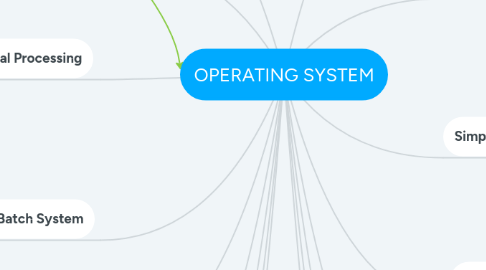OPERATING SYSTEM
DAVID LOO BOON HONGにより


1. Main Objective
1.1. Convenience
1.2. Efficiency
1.3. Ability to evolve
2. Role of OS
2.1. A computer is a set of resources for the movement,storage and processing of data
2.2. OS responsible for managing
3. Serial Processing
3.1. Earliest Computer
3.1.1. No Operating Systems
3.1.1.1. Computers ran from a display light,taggle switch some form of input device and printers
3.2. Problem
3.2.1. Scheduling
3.2.1.1. Set up time
4. Simple Batch System
4.1. Early computers were very expensive
5. Time Sharing Systems
5.1. Can be used to handle multiple interactive jobs
5.2. Processor time is shared among multiple users
6. Parallel System
6.1. Advantages
6.1.1. Increased Througput
6.1.2. Economical
6.1.3. Increased Reliability
7. Asymmetric Multiprocessing
7.1. Each processor is assigned a specific task
7.2. More common in extremely large systems
8. Soft Real Time Task
8.1. Has an associated deadline
8.2. Still make sense to complete task even has passed deadline
9. Distributed Systems
9.1. Loosely coupled systems
9.1.1. Each processor has its own local memory processor comminicated with one another through various communication lines
9.1.1.1. Advantages of Distributed Systems
9.1.1.1.1. Resources Sharing
9.1.1.1.2. Reliability
9.1.1.1.3. Computation Speed-up
10. Monitor Point of view
10.1. Monitor controls the events
10.2. Resident monitor is software always in memory
10.3. Job returns control to monitor
11. Processor Point of view
11.1. Processor executes instruction from thr memory containing the monitor
11.2. Control is passed to a job
11.3. Control is returned to the monitor
12. Simple Batch System Overhead
12.1. Processor time between execution of user programs and execution of monitor
12.2. Despite overhead the simple batch system improves utilization of the computer
13. Multi programmed Batch Systems
13.1. Processor is often idle
13.2. Several jobs are kept in main memory at the same time
14. Batch Multi programmed and Time Sharing
14.1. Batch Multoprogrammed
14.1.1. Maximize Processor use
14.2. Time Sharing
14.2.1. Minimize Response Time

